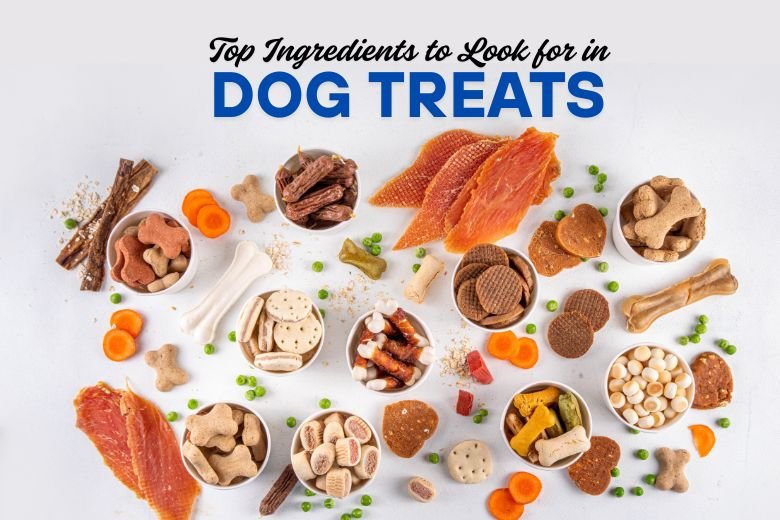Have you ever watched your dog’s eyes light up at the sound of the treat bag rustling? It’s a moment of pure joy, but as a pet parent, you want to ensure those treats are as healthy as they are exciting. With so many options on the shelves, picking the right dog treats can feel overwhelming. The key is knowing the top ingredients to look for in dog treats to keep your furry friend happy and healthy. This guide will walk you through the best ingredients, why they matter, and how to make informed choices for your pup.
Dog treats aren’t just about indulgence—they’re a chance to boost your dog’s nutrition, support their specific needs, and even strengthen your bond. Whether you’re training a new puppy or rewarding a loyal companion, understanding what goes into those treats is crucial. Let’s dive into the top ingredients to look for in dog treats and explore how they can benefit your dog’s health.
Why Ingredients Matter in Dog Treats
The ingredients in dog treats directly impact your pet’s well-being. Poor-quality treats loaded with fillers or artificial additives can lead to weight gain, allergies, or digestive issues. On the other hand, treats made with wholesome, nutrient-rich ingredients can support everything from a shiny coat to strong joints. By focusing on the top ingredients to look for in dog treats, you’re investing in your dog’s long-term health.
Studies show that 80% of pet owners consider ingredient quality a top priority when choosing pet food and treats (Pet Food Industry, 2023). High-quality ingredients ensure your dog gets the nutrition they need without empty calories or harmful additives.
Whole Meats as the Primary Ingredient
When scanning treat labels, always check that a whole meat—like chicken, beef, turkey, or salmon—is listed first. Whole meats are packed with protein, which supports muscle development and energy needs. Unlike vague terms like “meat by-products,” whole meats are minimally processed and provide essential amino acids.
- Why it’s great: Whole meats are highly digestible and mimic a dog’s natural diet.
- Example: A treat with “deboned chicken” as the first ingredient is a better choice than one listing “poultry meal.”
- Pro tip: Look for single-source proteins for dogs with food sensitivities.
Fruits and Vegetables for Natural Nutrients
Fruits and vegetables are powerhouse ingredients in dog treats, offering vitamins, minerals, and antioxidants. Ingredients like sweet potatoes, blueberries, and carrots are not only tasty but also provide health benefits.
- Sweet potatoes: Rich in fiber and beta-carotene for digestion and eye health.
- Blueberries: Packed with antioxidants to support immune health.
- Carrots: Great for dental health and low in calories.
These natural ingredients add flavor without artificial additives, making them some of the top ingredients to look for in dog treats for health-conscious pet owners.
Grain-Free Options for Sensitive Stomachs
Grain-free treats are a go-to for dogs with allergies or sensitive digestion. Ingredients like chickpeas, lentils, or coconut flour are excellent alternatives to wheat or corn, which can trigger reactions in some dogs.
- Why it’s important: About 10% of dogs have grain-related sensitivities (Veterinary Journal, 2022).
- Example: A grain-free treat with chickpea flour and salmon is ideal for dogs with wheat allergies.
- Look for: Labels that say “grain-free” or list alternative flours as the base.
Healthy Fats for Coat and Joint Health
Healthy fats, like those from fish oil, flaxseed, or chicken fat, are essential for a shiny coat and joint support. Omega-3 and omega-6 fatty acids reduce inflammation and promote skin health, especially for dogs with dry or itchy skin.
- Why it works: Omega-3s can reduce joint pain in older dogs by up to 20% (Journal of Veterinary Science, 2021).
- Example: Treats with salmon oil or flaxseed are excellent for coat health.
- Pro tip: Avoid treats with “animal fat” as it’s often low-quality and poorly defined.
Natural Preservatives Over Artificial Ones
Preservatives keep treats fresh, but not all are created equal. Natural preservatives like vitamin E (tocopherols) or rosemary extract are safer than artificial ones like BHA or BHT, which have been linked to health concerns in pets.
- Why it’s safer: Natural preservatives maintain quality without potential risks.
- Example: A treat preserved with mixed tocopherols is a better choice than one with BHT.
- Check for: Labels free of artificial colors and flavors, too.
Probiotics for Gut Health
Probiotics are increasingly popular in dog treats, supporting digestion and immune health. Ingredients like dried Lactobacillus or Bacillus subtilis promote a healthy gut microbiome, which is vital for dogs with sensitive stomachs.
- Why it’s beneficial: A balanced gut can reduce diarrhea and improve nutrient absorption.
- Example: Treats with added probiotics are great for dogs on antibiotics or with digestive issues.
- Look for: “Live cultures” or specific probiotic strains on the label.
Low-Calorie Ingredients for Weight Management
If your dog needs to watch their weight, low calorie top ingredients to look for in dog treats include green beans, pumpkin, or zucchini. These ingredients are filling but won’t pack on the pounds.
- Why it matters: Obesity affects 56% of dogs in the U.S. (Association for Pet Obesity Prevention, 2024).
- Example: Pumpkin-based treats are low-calorie and high in fiber.
- Tip: Use small, low-calorie treats for training to avoid overfeeding.
Novel Proteins for Allergy-Prone Dogs
For dogs with food allergies, novel proteins like venison, duck, or rabbit are excellent choices. These less common proteins reduce the risk of allergic reactions compared to chicken or beef.
- Why it’s helpful: Novel proteins can reduce itching and skin issues in sensitive dogs.
- Example: A venison-based treat is ideal for dogs allergic to poultry.
- Pro tip: Pair novel proteins with grain-free bases for maximum allergy relief.
Functional Ingredients for Specific Needs
Some treats include functional ingredients like glucosamine, chondroitin, or turmeric to target specific health concerns. These are especially useful for senior dogs or those with joint issues.
- Glucosamine and chondroitin: Support joint health and mobility.
- Turmeric: Reduces inflammation and may help with arthritis.
- Example: A treat with glucosamine is perfect for an aging dog with stiff joints.
Avoiding Harmful Fillers and Additives
Steer clear of treats with fillers like corn syrup, soy, or artificial flavors. These add no nutritional value and can cause digestive upset or weight gain.
- Red flags: Ingredients like “corn gluten meal” or “propylene glycol.”
- Why avoid them: Fillers can lead to long-term health issues like obesity or diabetes.
- Choose instead: Treats with whole, recognizable ingredients.
Reading Labels Like a Pro
Understanding dog treat labels is key to finding the top ingredients to look for in dog treats. Always check the ingredient list order—ingredients are listed by weight, so the first few are the most prominent. Avoid treats with vague terms like “meat meal” or “animal digest.”
- Tip: Look for short ingredient lists with recognizable, whole foods.
- Example: A label starting with “chicken, sweet potato, blueberries” is a good sign.
- Pro tip: Research brands with transparent sourcing for peace of mind.
Homemade Treats: Control the Ingredients
Making your own dog treats lets you control the quality and customize for your dog’s needs. Simple recipes using peanut butter, pumpkin, or oats are easy to whip up and ensure you’re using the top ingredients to look for in dog treats.
- Easy recipe: Mix 1 cup pumpkin puree, 2 cups oats, and ¼ cup peanut butter; bake at 350°F for 15 minutes.
- Why it’s great: You can avoid fillers and tailor to allergies.
- Link: Check our guide to homemade dog treats for more recipes.
Top Ingredients to Look for in Dog Treats – Frequently Asked Questions
What are the top ingredients to look for in dog treats?
The top ingredients to look for in dog treats include whole meats (like chicken or salmon), fruits and vegetables (such as sweet potatoes or blueberries), and healthy fats (like fish oil). These provide protein, vitamins, and omega-3s for overall health. See more in our Whole Meats section.
Are grain-free dog treats better for my dog?
Grain-free treats are ideal for dogs with grain allergies or sensitive stomachs. Ingredients like chickpeas or coconut flour are great alternatives. Learn more in our Grain-Free Options section.
What ingredients should I avoid in dog treats?
Avoid fillers like corn syrup, soy, or artificial preservatives like BHA. These can cause digestive issues or long-term health problems. Check our Avoiding Harmful Fillers section for details.
Can I give my dog treats with probiotics?
Yes, probiotics like Lactobacillus support gut health, especially for dogs with digestive issues. Look for treats with “live cultures” listed. See our Probiotics for Gut Health section.
Are homemade dog treats healthier than store-bought?
Homemade treats can be healthier since you control the ingredients, avoiding fillers and additives. Simple recipes with pumpkin or peanut butter are great. Explore our Homemade Treats section.
How do I choose low-calorie dog treats?
Opt for treats with low-calorie ingredients like pumpkin, green beans, or zucchini to support weight management. See our Low-Calorie Ingredients section for tips.
What are functional ingredients in dog treats?
Functional ingredients like glucosamine, chondroitin, or turmeric target specific health needs, such as joint support or inflammation reduction. Learn more in our Functional Ingredients section.
Conclusion
Choosing the right dog treats comes down to prioritizing the top ingredients to look for in dog treats—whole meats, fruits, vegetables, healthy fats, and natural preservatives. These ingredients ensure your dog gets nutrition, not just empty calories. By reading labels carefully and considering your dog’s unique needs, you can make every treat a healthy reward. Share your favorite treat picks in the comments or explore our guide to dog nutrition for more tips!
Choosing the right dog treats means prioritizing high-quality, natural ingredients that support your pet’s health. Look for top ingredients like whole meats, fruits, vegetables, and grain-free options to ensure your dog gets the best nutrition.
Top Ingredients to Look for in Dog Treats
Have you ever watched your dog’s eyes light up at the sound of the treat bag rustling? It’s a moment of pure joy, but as a pet parent, you want to ensure those treats are as healthy as they are exciting. With so many options on the shelves, picking the right dog treats can feel overwhelming. The key is knowing the top ingredients to look for in dog treats to keep your furry friend happy and healthy. This guide will walk you through the best ingredients, why they matter, and how to make informed choices for your pup.
Dog treats aren’t just about indulgence—they’re a chance to boost your dog’s nutrition, support their specific needs, and even strengthen your bond. Whether you’re training a new puppy or rewarding a loyal companion, understanding what goes into those treats is crucial. Let’s dive into the top ingredients to look for in dog treats and explore how they can benefit your dog’s health.
Why Ingredients Matter in Dog Treats
The ingredients in dog treats directly impact your pet’s well-being. Poor-quality treats loaded with fillers or artificial additives can lead to weight gain, allergies, or digestive issues. On the other hand, treats made with wholesome, nutrient-rich ingredients can support everything from a shiny coat to strong joints. By focusing on the top ingredients to look for in dog treats, you’re investing in your dog’s long-term health.
Studies show that 80% of pet owners consider ingredient quality a top priority when choosing pet food and treats (Pet Food Industry, 2023). High-quality ingredients ensure your dog gets the nutrition they need without empty calories or harmful additives.
Whole Meats as the Primary Ingredient
When scanning treat labels, always check that a whole meat—like chicken, beef, turkey, or salmon—is listed first. Whole meats are packed with protein, which supports muscle development and energy needs. Unlike vague terms like “meat by-products,” whole meats are minimally processed and provide essential amino acids.
- Why it’s great: Whole meats are highly digestible and mimic a dog’s natural diet.
- Example: A treat with “deboned chicken” as the first ingredient is a better choice than one listing “poultry meal.”
- Pro tip: Look for single-source proteins for dogs with food sensitivities.
Fruits and Vegetables for Natural Nutrients
Fruits and vegetables are powerhouse ingredients in dog treats, offering vitamins, minerals, and antioxidants. Ingredients like sweet potatoes, blueberries, and carrots are not only tasty but also provide health benefits.
- Sweet potatoes: Rich in fiber and beta-carotene for digestion and eye health.
- Blueberries: Packed with antioxidants to support immune health.
- Carrots: Great for dental health and low in calories.
These natural ingredients add flavor without artificial additives, making them some of the top ingredients to look for in dog treats for health-conscious pet owners.
Grain-Free Options for Sensitive Stomachs
Grain-free treats are a go-to for dogs with allergies or sensitive digestion. Ingredients like chickpeas, lentils, or coconut flour are excellent alternatives to wheat or corn, which can trigger reactions in some dogs.
- Why it’s important: About 10% of dogs have grain-related sensitivities (Veterinary Journal, 2022).
- Example: A grain-free treat with chickpea flour and salmon is ideal for dogs with wheat allergies.
- Look for: Labels that say “grain-free” or list alternative flours as the base.
Healthy Fats for Coat and Joint Health
Healthy fats, like those from fish oil, flaxseed, or chicken fat, are essential for a shiny coat and joint support. Omega-3 and omega-6 fatty acids reduce inflammation and promote skin health, especially for dogs with dry or itchy skin.
- Why it works: Omega-3s can reduce joint pain in older dogs by up to 20% (Journal of Veterinary Science, 2021).
- Example: Treats with salmon oil or flaxseed are excellent for coat health.
- Pro tip: Avoid treats with “animal fat” as it’s often low-quality and poorly defined.
Natural Preservatives Over Artificial Ones
Preservatives keep treats fresh, but not all are created equal. Natural preservatives like vitamin E (tocopherols) or rosemary extract are safer than artificial ones like BHA or BHT, which have been linked to health concerns in pets.
- Why it’s safer: Natural preservatives maintain quality without potential risks.
- Example: A treat preserved with mixed tocopherols is a better choice than one with BHT.
- Check for: Labels free of artificial colors and flavors, too.
Probiotics for Gut Health
Probiotics are increasingly popular in dog treats, supporting digestion and immune health. Ingredients like dried Lactobacillus or Bacillus subtilis promote a healthy gut microbiome, which is vital for dogs with sensitive stomachs.
- Why it’s beneficial: A balanced gut can reduce diarrhea and improve nutrient absorption.
- Example: Treats with added probiotics are great for dogs on antibiotics or with digestive issues.
- Look for: “Live cultures” or specific probiotic strains on the label.
Low-Calorie Ingredients for Weight Management
If your dog needs to watch their weight, low calorie top ingredients to look for in dog treats include green beans, pumpkin, or zucchini. These ingredients are filling but won’t pack on the pounds.
- Why it matters: Obesity affects 56% of dogs in the U.S. (Association for Pet Obesity Prevention, 2024).
- Example: Pumpkin-based treats are low-calorie and high in fiber.
- Tip: Use small, low-calorie treats for training to avoid overfeeding.
Novel Proteins for Allergy-Prone Dogs
For dogs with food allergies, novel proteins like venison, duck, or rabbit are excellent choices. These less common proteins reduce the risk of allergic reactions compared to chicken or beef.
- Why it’s helpful: Novel proteins can reduce itching and skin issues in sensitive dogs.
- Example: A venison-based treat is ideal for dogs allergic to poultry.
- Pro tip: Pair novel proteins with grain-free bases for maximum allergy relief.
Functional Ingredients for Specific Needs
Some treats include functional ingredients like glucosamine, chondroitin, or turmeric to target specific health concerns. These are especially useful for senior dogs or those with joint issues.
- Glucosamine and chondroitin: Support joint health and mobility.
- Turmeric: Reduces inflammation and may help with arthritis.
- Example: A treat with glucosamine is perfect for an aging dog with stiff joints.
Avoiding Harmful Fillers and Additives
Steer clear of treats with fillers like corn syrup, soy, or artificial flavors. These add no nutritional value and can cause digestive upset or weight gain.
- Red flags: Ingredients like “corn gluten meal” or “propylene glycol.”
- Why avoid them: Fillers can lead to long-term health issues like obesity or diabetes.
- Choose instead: Treats with whole, recognizable ingredients.
Reading Labels Like a Pro
Understanding dog treat labels is key to finding the top ingredients to look for in dog treats. Always check the ingredient list order—ingredients are listed by weight, so the first few are the most prominent. Avoid treats with vague terms like “meat meal” or “animal digest.”
- Tip: Look for short ingredient lists with recognizable, whole foods.
- Example: A label starting with “chicken, sweet potato, blueberries” is a good sign.
- Pro tip: Research brands with transparent sourcing for peace of mind.
Homemade Treats: Control the Ingredients
Making your own dog treats lets you control the quality and customize for your dog’s needs. Simple recipes using peanut butter, pumpkin, or oats are easy to whip up and ensure you’re using the top ingredients to look for in dog treats.
- Easy recipe: Mix 1 cup pumpkin puree, 2 cups oats, and ¼ cup peanut butter; bake at 350°F for 15 minutes.
- Why it’s great: You can avoid fillers and tailor to allergies.
- Link: Check our guide to homemade dog treats for more recipes.
Top Ingredients to Look for in Dog Treats – Frequently Asked Questions
What are the top ingredients to look for in dog treats?
The top ingredients to look for in dog treats include whole meats (like chicken or salmon), fruits and vegetables (such as sweet potatoes or blueberries), and healthy fats (like fish oil). These provide protein, vitamins, and omega-3s for overall health. See more in our Whole Meats section.
Are grain-free dog treats better for my dog?
Grain-free treats are ideal for dogs with grain allergies or sensitive stomachs. Ingredients like chickpeas or coconut flour are great alternatives. Learn more in our Grain-Free Options section.
What ingredients should I avoid in dog treats?
Avoid fillers like corn syrup, soy, or artificial preservatives like BHA. These can cause digestive issues or long-term health problems. Check our Avoiding Harmful Fillers section for details.
Can I give my dog treats with probiotics?
Yes, probiotics like Lactobacillus support gut health, especially for dogs with digestive issues. Look for treats with “live cultures” listed. See our Probiotics for Gut Health section.
Are homemade dog treats healthier than store-bought?
Homemade treats can be healthier since you control the ingredients, avoiding fillers and additives. Simple recipes with pumpkin or peanut butter are great. Explore our Homemade Treats section.
How do I choose low-calorie dog treats?
Opt for treats with low-calorie ingredients like pumpkin, green beans, or zucchini to support weight management. See our Low-Calorie Ingredients section for tips.
What are functional ingredients in dog treats?
Functional ingredients like glucosamine, chondroitin, or turmeric target specific health needs, such as joint support or inflammation reduction. Learn more in our Functional Ingredients section.
Conclusion
Choosing the right dog treats comes down to prioritizing the top ingredients to look for in dog treats—whole meats, fruits, vegetables, healthy fats, and natural preservatives. These ingredients ensure your dog gets nutrition, not just empty calories. By reading labels carefully and considering your dog’s unique needs, you can make every treat a healthy reward. Share your favorite treat picks in the comments or explore our guide to dog nutrition for more tips!




